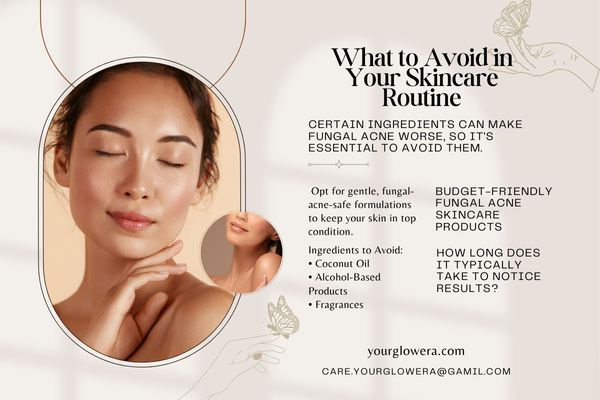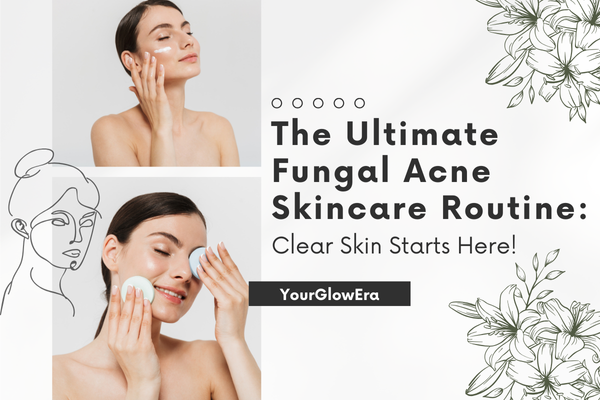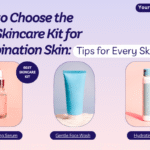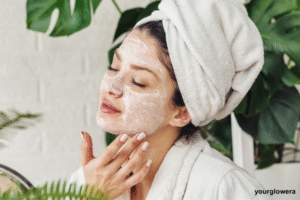Introduction to Fungal Acne Skincare Routine
If you’re struggling with fungal acne, you’re not alone. Many people experience fungal acne, and it can be a frustrating condition to manage. Fortunately, with the right fungal acne skincare routine, you can take control and help your skin recover.
Fungal acne, also known as Malassezia folliculitis, requires specific care that differs from traditional acne. Understanding what causes it, how to prevent it, and which products to use can significantly improve your skin’s health.
This guide will walk you through an effective fungal acne skincare routine, step by step, while offering budget-friendly advice for those looking for affordable yet effective treatments. Let’s dive in and get you on your way to clear, glowing skin!
Table of Contents
1. What Is Fungal Acne?
Fungal acne isn’t actually a typical type of acne at all. It is caused by an overgrowth of yeast (Malassezia) in hair follicles, which leads to small, pimple-like bumps, often accompanied by itching and irritation.
Unlike regular acne, which is caused by excess oil and clogged pores, fungal acne results from an imbalance in your skin’s microbiome.
Key Points:
• Fungal acne manifests as tiny, consistent bumps on the skin’s surface.
• It commonly occurs on the forehead, shoulders, chest, and back.
• Although it resembles regular acne, fungal acne requires a different treatment approach for effective results.
2. What Causes Fungal Acne?
The primary cause of fungal acne is an overgrowth of yeast, but several factors can contribute to its development. These include excessive sweating, wearing tight clothing, using heavy skincare products that clog pores, and having an imbalance in your skin’s natural oils.
Fungal acne can also be triggered by antibiotics, which disrupt the balance of bacteria and yeast on your skin.
Key Points:
• Humidity & Sweat: Sweating, especially in hot and humid conditions, can trigger fungal acne.
• Antibiotics: They can disrupt your skin’s natural microbiome and increase the risk of fungal growth.
• Oily skin: Excess oil provides an ideal environment for yeast growth, which can contribute to issues like fungal acne.
3. How to Prevent Fungal Acne
Prevention is key when it comes to fungal acne. A proper skincare routine tailored for fungal acne can help minimize the risk of its development.
Start by keeping your skin clean and dry, especially after workouts or when exposed to humid conditions. Wearing loose-fitting clothing and using non-comedogenic (non-pore-clogging) skincare products can also help prevent breakouts.
Tips to Prevent Fungal Acne:
• Shower Immediately After Sweating: Sweat provides a breeding ground for yeast.
• Use Non-Comedogenic Products: Avoid products that block your pores, such as oils.
• Keep Your Skin Dry: Use an antifungal powder or body powder to absorb moisture.
4. What is the most effective way to treat fungal acne?
The best way to treat fungal acne involves a combination of proper skincare, antifungal treatments, and consistency. The right products can target the yeast causing the issue and help restore balance to your skin.
In this article, we’ll explore which treatments work best and how to incorporate them into your fungal acne skincare routine.
Key Steps for Treatment:
• Use Antifungal Creams or Gels: These target the root cause – yeast.
• Cleanse with Antifungal Ingredients: Use a gentle, effective cleanser to fight yeast.
• Exfoliate: Regular exfoliation can help prevent buildup of dead skin.

5. Importance of Using the Right Cleanser
The first step in any skincare routine is cleansing, and it’s crucial to choose the right cleanser for fungal acne. Look for gentle, non-comedogenic cleansers that are free of oils that could exacerbate the condition.
Antifungal cleansers containing ingredients like selenium sulfide or ketoconazole are ideal for your fungal acne skincare routine, as they help remove excess yeast and prevent future breakouts.
Best Cleansers for Fungal Acne:
• Selenium Sulfide-Based Cleansers: Effective at treating fungal acne.
• Ketoconazole Cleansers: Known for its antifungal properties.
• Gentle Gel Cleansers: Without oils or fragrances that could irritate the skin.
6. How to Choose the Best Exfoliator for Fungal Acne
Exfoliation helps to remove dead skin cells and prevent clogged pores, but not all exfoliators are suitable for fungal acne.
Choose chemical exfoliants like salicylic acid or glycolic acid in your fungal acne skincare routine, as they help prevent buildup without irritating the skin. Avoid physical scrubs, as they can aggravate fungal acne.
Best Exfoliators for Fungal Acne:
• Salicylic Acid: Helps to thoroughly clean pores and remove dead skin cells.
• Glycolic Acid: A gentle exfoliant that promotes the shedding of dead skin and boosts skin renewal.
• Avoid Scrubs: Physical exfoliants can worsen fungal acne by causing irritation.
7. Treatment Products to Include in Your Routine
Antifungal treatments are a cornerstone of any fungal acne skincare routine. Look for creams, gels, or serums that contain antifungal ingredients such as ketoconazole, ciclopirox, or clotrimazole.
These products help to kill the yeast that causes fungal acne and prevent further outbreaks.
Must-Have Antifungal Products:
• Ketoconazole Cream: Often used to treat fungal acne effectively.
• Ciclopirox Gel: Another antifungal treatment that can clear up fungal acne.
• Clotrimazole: A common antifungal cream used for skin conditions.
8. Using Niacinamide for Fungal Acne
Niacinamide, also known as Vitamin B3, is a beneficial ingredient in your fungal acne skincare routine that helps decrease inflammation and redness linked to fungal acne.
It also strengthens the skin’s barrier, improving its ability to retain moisture and protect against further irritation.
Benefits of Niacinamide:
• Reduces Inflammation: Soothes irritation and helps calm the skin.
• Boosts Skin Barrier: Strengthens your skin’s natural defenses.
• Controls Oil Production: Helps balance oil levels on the skin’s surface.
9. Hydration is Key
While treating fungal acne, don’t forget to hydrate your skin. Using a lightweight, oil-free moisturizer will help maintain the skin’s natural moisture balance without contributing to fungal acne.
Look for products with hyaluronic acid in your fungal acne skincare routine, as it hydrates the skin without clogging pores.
Best Hydrating Ingredients:
• Hyaluronic Acid: Keeps the skin hydrated and plump.
• Glycerin: It give moisture to the skin and helps lock it in, ensuring your skin remains hydrated, soft, and supple.
• Ceramides: Strengthen the skin’s barrier and support long-lasting hydration.
10. Sunscreen for Fungal Acne
Additionally, incorporating sunscreen into your fungal acne skincare routine is vital to protect your skin from harmful UV rays, especially when dealing with fungal acne.
When using antifungal treatments and exfoliating agents, your skin becomes more sensitive to the sun. Select a broad-spectrum, oil-free sunscreen with SPF 30 or higher to shield your skin from UV rays.
Best Sunscreens for Fungal Acne:
• Oil-Free Sunscreens: Prevent clogging pores and worsening acne.
• Broad-spectrum SPF 30+ provides protection against both UVA and UVB rays, helping to prevent skin damage and maintain overall skin health.
• Non-Comedogenic: Ensure the sunscreen won’t cause further breakouts.
11. What to Avoid in Your Skincare Routine
Certain ingredients can make fungal acne worse, so it’s essential to avoid them. Heavy oils like coconut oil, as well as products containing alcohol or fragrances, can exacerbate fungal acne.
Opt for gentle, fungal-acne-safe formulations to maintain your skin’s health and support your fungal acne skincare routine.
Ingredients to Avoid:
• Coconut Oil: This can clog pores and feed yeast.
• Alcohol-Based Products: containing alcohol can cause dryness and irritation to the skin.
• Fragrances: Can cause irritation and worsen fungal acne.

12. Budget-Friendly Fungal Acne Skincare Products
Effective skincare doesn’t need to be costly. Some affordable options for treating fungal acne include brands like CeraVe, Vanicream, and The Ordinary.
Look for antifungal treatments, cleansers, and moisturizers from these trusted brands that fit within your budget, and make sure they align with your fungal acne skincare routine.
Affordable Product Recommendations:
• CeraVe Antifungal Cleanser: A budget-friendly, effective option for fungal acne.
• Vanicream Moisturizing Cream: Gentle on the skin, especially for sensitive types.
• The Ordinary Niacinamide: A powerful, affordable serum for controlling inflammation.
13.How long does it typically take to notice results?
When following a fungal acne skincare routine, patience is key. You may begin to see improvements within 1-2 weeks, but full results can take up to a month or longer.
Consistency with your routine is important to prevent fungal acne from returning.
Timeline Expectations:
• 1-2 Weeks: Notice a reduction in redness and inflammation.
• 3-4 Weeks: Begin to see clearer skin with fewer breakouts.
• 1 Month+: Full results with healthy, clear skin.
14. When to See a Dermatologist
If your fungal acne persists or worsens despite following a proper skincare routine, it’s a good idea to consult a dermatologist to ensure your fungal acne skincare routine is effective and suited to your skin’s needs.
They can prescribe stronger antifungal treatments or suggest additional methods to help manage your condition.
Signs to See a Dermatologist:
• Persistent Breakouts: If your fungal acne doesn’t improve after 2-4 weeks of treatment.
• Severe Irritation: If your skin becomes overly irritated or sensitive.
• Worsening Condition: If your fungal acne spreads or becomes more inflamed.
15. Tips for Maintaining Clear Skin Long-Term
Once you’ve cleared up your fungal acne, it’s essential to maintain your fungal acne skincare routine to prevent future breakouts. Sticking to a consistent routine with the right antifungal products helps keep the yeast under control and your skin clear.
Continue to use non-comedogenic products, practice good hygiene, and keep your skin balanced by hydrating and protecting it from the sun.
Long-Term Maintenance Tips:
• Stay Hydrated: Consuming enough water is crucial for keeping your skin healthy, radiant, and well-moisturized.
• Always Wear Sunscreen: Protect your skin from UV rays to prevent damage.
• Stay Consistent: Stick to your routine to prevent fungal acne from returning.

Conclusion
Incorporating the right products into your fungal acne skincare routine is essential for achieving clear, healthy skin.
By following the steps outlined in this guide, you’ll be able to reduce breakouts, manage your skin’s oil production, and keep fungal acne under control. Remember, staying consistent is essential, and with patience, you’ll achieve the results you’re aiming for.
If you’re struggling with fungal acne and looking for ways to clear up your skin, this guide is for you! In our article, “Fungal Acne Skincare Routine: Everything You Need for Healthy, Clear Skin“, we dive into all the essential steps and tips you need to know for a skincare routine that targets fungal acne specifically.
Whether you’re new to dealing with fungal acne or have been struggling with it for a while, this comprehensive guide will help you find the right products and techniques to restore your skin’s balance and clarity. Make sure to check it out and take the first step towards healthier, clearer skin!
Frequently Asked Questions
1. Is hyaluronic acid good for fungal acne?
Yes, hyaluronic acid is safe and beneficial for fungal acne. It hydrates the skin without clogging pores or encouraging fungal growth, as it’s lightweight and non-comedogenic.
2. How to know if fungal acne is healing?
Fungal acne will typically begin to flatten and reduce in size once treated properly. The redness and inflammation should diminish, and the itchy sensation should lessen as the yeast overgrowth is controlled.
3. Is almond clear good for fungal acne?
Almond Clear is a gentle exfoliating toner that may work for fungal acne, as it helps remove excess oils and dead skin cells without irritating the skin. Ensure it doesn’t contain oils that could exacerbate fungal acne.
4. Is aloe vera good for fungal acne?
Aloe vera is generally soothing and anti-inflammatory, making it beneficial for calming irritated skin due to fungal acne. However, it may not directly treat the fungal yeast, so it’s best to pair it with antifungal treatments.
5. Which serum is best for fungal acne?
Look for serums that contain niacinamide or zinc. These ingredients can help reduce inflammation and regulate oil production without feeding the yeast causing fungal acne.
6. What is the fastest way to get rid of fungal acne?
The fastest way is to use an antifungal treatment consistently, such as ketoconazole cream or selenium sulfide shampoo, combined with a gentle skincare routine to avoid further irritation.
7. Why does my skin fungus keep coming back?
Fungal acne can recur if the environment on your skin continues to promote yeast growth. This includes factors like sweating, wearing tight clothing, using oily skincare, and not completing your antifungal treatment regimen.
8. Does lemon help fungal acne?
Lemon has some natural antibacterial and antifungal properties but can also irritate sensitive skin. It is not the most effective or recommended remedy for fungal acne.
9. Can turmeric remove fungal acne?
Turmeric has anti-inflammatory and antibacterial properties, which may help with inflammation and skin healing. However, it is not a proven antifungal solution for fungal acne.
10. Does AHA and BHA help with fungal acne?
AHA (alpha hydroxy acid) and BHA (beta hydroxy acid) can help with exfoliation, but they do not directly target fungal acne. BHA, in particular, can help with oil control, which might indirectly improve fungal acne.
11. What is fungal acne, and how is it different from regular acne?
Fungal acne, also known as Malassezia folliculitis, occurs when yeast naturally found on the skin overgrows and infects hair follicles, causing bumps and pimples. Unlike regular acne, which is caused by clogged pores and bacteria, fungal acne is linked to an overgrowth of yeast.
12. How can I tell if I have fungal acne?
Fungal acne typically presents as small, uniform bumps that are often itchy. They are usually found on the forehead, chest, or back. If your acne doesn’t respond to typical acne treatments or worsens with oily skincare products, it may be fungal acne.
13. What ingredients should I look for in skincare products for fungal acne?
When treating fungal acne, it’s essential to look for products that contain ingredients like ketoconazole, zinc pyrithione, or sulfur. These ingredients are antifungal and can help reduce the yeast overgrowth. Avoid products with oils that feed the yeast, such as coconut oil or olive oil.
14. Can I use my regular skincare products for fungal acne?
Not all skincare products are suitable for fungal acne. Many products that are great for regular acne may contain oils or ingredients that can worsen fungal acne. It’s important to use products specifically formulated for fungal acne to prevent irritation and flare-ups.
15. How long does it take to see results from a fungal acne skincare routine?
Results can vary depending on the severity of the fungal acne and how consistently you follow your skincare routine. However, most people begin to see improvements within 2–4 weeks of using the right products and following a dedicated routine. Patience is key when treating fungal acne.









Leave a reply